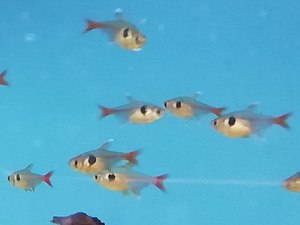Yellow phantom tetra
| Yellow phantom tetra | ||||||||||||
|---|---|---|---|---|---|---|---|---|---|---|---|---|

Yellow phantom tetra ( Hyphessobrycon roseus ) |
||||||||||||
| Systematics | ||||||||||||
|
||||||||||||
| Scientific name | ||||||||||||
| Hyphessobrycon roseus | ||||||||||||
| ( Géry , 1960) |
The yellow phantom tetra ( Hyphessobrycon roseus , syn .: Megalomphodus roseus ) is a freshwater fish from the family of the real tetra that comes from the waters of French Guyana (catchment area of the middle and upper chestnuts and oyapock ) and Surinam ( Tapanahony ) .
features
The petite animals reach a length of only about 3 cm. In contrast to many other representatives of the genus Hyphessobrycon , its dorsal and anal fins are not drawn out like a flag. Its back is brown-olive, the sides pink, the belly yellowish-white. Behind the gill cover is a large, downwardly pointed black spot. The iris is black, the caudal fin stalk and the region above the anal fin are red-brown, the outer areas of the dorsal fin and the first rays of the anal fin are blue-white.
The yellow phantom tetra lacks the pronounced sexual dimorphism of the other phantom tetra species. The males are a bit slimmer than the higher back females. In addition, in contrast to the males, the females often have a yellow spot on the base of the anterior dorsal fin.
Way of life
In its area of distribution, the yellow phantom tetra lives on the edge of streams and inlets of rivers with little flow. The bank areas are characterized by emersed bank vegetation reaching into the water , a lot of dead wood and a layer of leaves covering the bottom of the water.
Measured values at the Tapanahony site at 25 ° C resulted in very soft (KH and GH <1 ° dH), acidic (pH 6.5) and low-salt water (conductivity <10 µS / cm).
Aquaristics
attitude
The yellow phantom tetra was first imported to Germany in 1984 (1978 to Holland). A group with no fewer than 12 specimens of the Yellow Phantom Tetra should be kept in a well-planted pool that still leaves enough space for swimming . A socialization is only recommended with other, smaller, non-predatory species. The pool length should be at least 60 cm, better 100 cm. Keeping them in medium-hard and slightly alkaline water is possible. Dry, fine live food and frozen food are accepted as feed.
Like most tetra species, the yellow phantom tetra is only a schooling fish in the event of danger or as a young animal . Otherwise he looks for an individual distance to his fellow species and shows an interesting social behavior with imposing behavior and ritualized mock fights .
Reproduction and breeding
The reproduction and breeding of the yellow phantom tetra hardly differs from that of the black phantom tetra . The previously proven upper limit of water hardness is 4 ° dGH and is thus lower than that of the black phantom tetra. Successful breeding has so far only been possible in peat-filtered water.
See also
swell
literature
- Wolfgang Staeck: Tetra from South America. Dähne Verlag, 2008, ISBN 3-935175-41-8 .
- Axel Zarske: Hyphessobrycon roseus. In: Claus Schaefer, Torsten Schröer (Hrsg.): The large lexicon of aquaristics. Eugen Ulmer, Stuttgart 2004, ISBN 3-8001-7497-9 , p. 504.
- Hans A. Baensch : Aquariums Atlas. Volume 2, Mergus Verlag, 2002, paperback edition, ISBN 3-88244-014-7 .
- Helmut Pinter: Handbook of aquarium fish breeding. Verlag Eugen Ulmer, 1998, ISBN 3-8001-7391-3 .
Individual evidence
- ↑ a b c d e f Wolfgang Staeck: Tetra from South America. Dähne Verlag, 2008, ISBN 3-935175-41-8 , pp. 108-109.
- ^ Axel Zarske: Hyphessobrycon roseus. 2004, p. 504.
- ↑ Hans A. Baensch: Aquarien Atlas 2. Verlag Mergus 2002, paperback edition, ISBN 3-88244-014-7 , p. 282.
- ↑ Helmut Pinter: Handbook of aquarium fish breeding. Verlag Eugen Ulmer, 1998, ISBN 3-8001-7391-3 , pp. 64-67.
Web links
- Yellow phantom tetra on Fishbase.org (English)
- www.zierfischverzeichnis.de